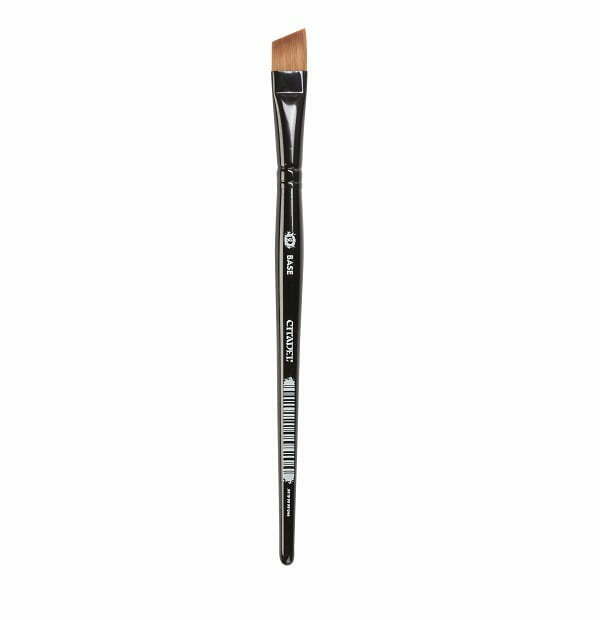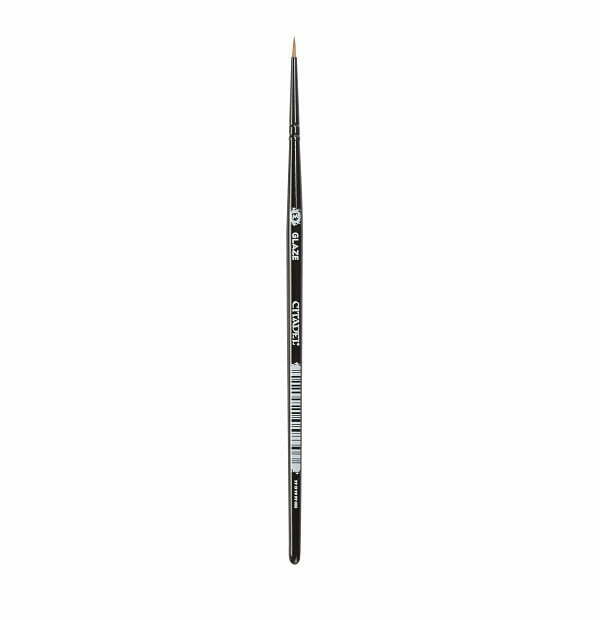This will be a series of articles on how to improve your paint, next we have brushes. Edwin Moriarty is a commission painter and games developer living in Nottingham, UK. Keep up with his latest projects on Instagram.
Now we move on to the essential tools that are used to apply the paint to the models. The ancients called these… Man I dunno. Bunch of different things probably. Who cares, they’re dead now.
Citadel brushes are a strange beast and this is the article in which I’ll probably be most critical of geedubs, because man some of their brushes are bad, and most of them are badly overpriced. That said, I do still use them for a lot of my painting, because better replacements for everything isn’t easy.
At the moment GW sell a number of different types of brush, most of which come in a couple of sizes. The types are:
- Base
- Layer
- Dry
- Shade
- Glaze
- Scenery
- Artificer Layer
A lot of that list will be familiar to you after the last article, and indeed the intention is you will match the brush type to the paint type for best results. That doesn’t always work, however, and there are a few curve balls in there, so let’s dig in a bit further.
Some stuff about brushes
Just like with paint this will all make a lot more sense if you know some stuff about brushes, so let’s cover the basics. The kind of brushes that we use were originally intended for watercolour painting. That’s because we use such fine pigment paint with so much flow that standard acrylic brushes, which are much stiffer and coarser, aren’t appropriate.
Watercolour brushes were traditionally made from animal hair like most artist’s brushes. The general consensus is that the best material is kolinsky sable – the tale fur of a kind of Russian weasel. These animals are farmed specifically for this, and the very finest quality brushes are made from male red sable.
Weasel arse hair is surprisingly pricey, however, so alternatives have sprung up. Some other hairs are used, but the most common alternative is synthetic hair. This is plastic, and is much cheaper but generally considered much less good than sable.
GW uses a mixture of different hairs and synthetics in its brushes, as they’re useful for different things. All their brushes are made by veteran brush makers Winsor and Newton, though to the specific requirements of GW.
Base brushes
Base brushes are intended for the application of base paints, and more broadly all base layers. They’re a blend of cheap sable and synthetic, and rather stiff, so you can more easily push paint into crevasses without the brush point splitting. However, like many synthetics, they have a tendency to curl – the head of the brush slowly bends over at the tip as the bristles contract at different rates. This is a quick step to a ruined brush.
They come in small, medium, large and extra large sizes. Large and extra large come in a flat shape rather than a round.
I honestly wouldn’t recommend them. They wear out fast due to curling, and some cheap brushes from a craft store will do as well.
Layer brushes
Layer brushes are much softer than base brushes and intended for use with layer and edge paints. You can also use them for glazes and shades without any ill effect. They’re pure sable, but of middling quality, but they very much do the job. They’re also a good length of tip, generally well made, and last.
Layer brushes come in a small and medium, and I would broadly recommend them. Particularly as the quality of high end sable brushes has fallen, you’ll find these nearly as good and decently cheap. You can buy alternatives at W&N direct but those have longer bristles for watercolour painting and aren’t always that useful. I do much of my painting with these brushes, including a lot of base coat application.
Dry brushes
These stiff brushes are a mix of ox hair and synthetic fibres and are intended solely for dry brushing. For that purpose they work great, and it’s hard to criticize them. They come in small, medium and large, and are all flat headed.
Shade brushes
These pure ox hair brushes are stiff and really designed just to hold a lot of paint for efficient application of shade paints. They come in round head medium and large, and are… fine. They’re basically unnecessary but they do the job.
Glaze brushes
 A completely synthetic brush for… some reason. Comes in a medium. I have no idea why this exists, it seems to be totally useless.
A completely synthetic brush for… some reason. Comes in a medium. I have no idea why this exists, it seems to be totally useless.
Scenery brushes
These large brushes are intended to let you paint very large areas quickly and efficiently. They’re synthetic but a soft fibre, and really do the job well considering the price point. There is a medium round and a large flat, but both a big brushes.
Artificer Layer brushes
So I put this one off until last because it’s most complicated.
Artificer brushes unlike the other brushes were created entire for GW’s internal benefit. The Eavy Metal team when they were told that they needed to stop using W&N branded brushes wanted replacements for the small size Series 7s they used, which at the time were probably the best brushes of their kind in the world. GW’s solution was to get W&N to make them some new citadel branded brushes to fill this gap at the same quality standard of their premium Series 7 range. Thus, artificers were born.
To start with there was no doubt that artificiers were excellent brushes – they were just Series 7 brushes after all. But at that time the advice would have been “Just buy Series 7 and don’t pay GW a surcharge for branding.”
In recent years though, things are not as clear cut. The quality of Series 7 brushes has tumbled and while some painters report brushes nearly as good as their previous quality, getting one like that seems potluck. This decline is due to difficulties in securing high quality sable and is a problem for all premium sable brush companies. However as Series 7 has declined so has the artificer series. It is hard to recommend them over the cheaper layer brushes currently.
They come in extra small, small and medium, but I would honestly say save your money. There are some premium brands out there still (Broken Toad and Rosemary and Co are commonly recommended) but stock issues are chronic.
Next time we’ll look at hobby accessories and how they fit in.
For more in the series see:

Good info.
I’ve had mixed luck with the layer brushes. My small one is still going strong a year later. My first medium one lasted a good 6 months, but the replacement was really only good for a few weeks. I also take good care of my brushes as well.
Recently I picked up some Raphael 8404 brushes and they’ve been amazing. I’m not sure if they’re running into quality issues like W&N, but the ones I picked up have been great.
That was a very interesting and informative read. Thanks!
That last bit puts me in a bit of a quandary, tho. I’ve been thinking about picking up something better than the GW Layer brushes lately because I’m getting to the point as a painter where I can actually do that level of detail work. But I really don’t want gamble with brushes that expensive.
The Raphael 8404 are a bit cheaper than W&N Series 7 and every bit as good. Also, the beauty of a good brush is you only need a few. I’m doing most of my work with a #2 and #1 brush, which would be like a GW large and medium layer brush. Because a good brush holds a point very well, you can do some crazy detail work with a big brush.
I also bought mine off Blick: https://www.dickblick.com/
They’re a big art supply site. I went with them because in checking out Amazon I saw complaints from buyers on the quality brushes they were getting; many claiming the seller was giving them lower quality versions. So, I cut out the middleman with Amazon and went for a direct supplier.
Yeah, some people have definitely got good ones. It’s the uncertainty that gets me.
That said, there actually is a Blick store not too far from me, and I’ve been wanting to get over that way for a while now. Maybe I’ll see if one of the clerks there can shift the odds in my favour.
I’d be interested to see a comparison with Army Painter brushes. I’ve been using them for about a year now and I think they’re on par with the Citadel brushes, just much cheaper. Having said that, I do have a W&N series 7 for detail work and it’s a beautiful thing.
I’ve noticed that I’ve gotten some curling on my small base brush come to think of it. I do like the dry brushes, but the only thing I don’t like is that even the smallest one is too large for some things I need, and I find myself using a lot of old brushes that I’ve cut down to be dry brushes.
Good to know. I just got some Citadel brushes, I’m not happy. One was an Artificer, it & the others shed hairs like nobody’s business. The XS Artificier has MAYBE 6 hairs left???
I thought they were all sable.
I just bought 3 Raphael 8404s, in 0, 02, & 06 (out of stock on 04) at Jackson’s Art Supply. First time buyers get free shipping & 10% discount. I hope those will be much better, my fingers are crossed. Otherwise, I’ll start making brushes out of my German Shepherd’s hair….🤣🤣